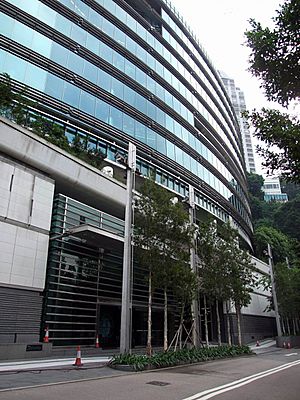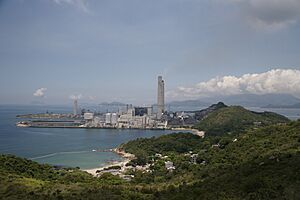Hongkong Electric Company facts for kids
 |
|

Hongkong Electric Company headquarters in Mid-Levels, Hong Kong
|
|
|
Trade name
|
HK Electric Investments and HK Electric Investments |
|---|---|
| Public | |
| Traded as | SEHK: 2638 |
| ISIN | ISIN: [https://isin.toolforge.org/?language=en&isin=HK0000179108 HK0000179108] |
| Industry | Public utility |
| Founded | 1 December 1890 in British Hong Kong |
| Headquarters | Hongkong Electric Centre, 44 Kennedy Road, Mid-levels, |
|
Key people
|
|
| Products | Electric service |
| Revenue | HK$ 11,344 million (2021) |
| Total assets | |
|
Number of employees
|
1,682 (2022) |
| Hongkong Electric Company | |||||||||||
|---|---|---|---|---|---|---|---|---|---|---|---|
| Traditional Chinese | 香港電燈有限公司 | ||||||||||
| Simplified Chinese | 香港电灯有限公司 | ||||||||||
|
|||||||||||
| HK Electric | |||||||||||
| Traditional Chinese | 港燈 | ||||||||||
| Simplified Chinese | 港灯 | ||||||||||
|
|||||||||||
The Hongkong Electric Company (HEC; Chinese: 香港電燈有限公司), also known as HK Electric, is one of the two main companies that make electricity for Hong Kong. The other company is China Light & Power. HK Electric is owned by several companies, including Power Assets Holdings and Cheung Kong Infrastructure Holdings.
It was the very first company to provide electricity in Hong Kong. It has been working non-stop since the late 1800s!
Contents
History of HK Electric
Back in 1888, a man named Bendyshe Layton suggested that Hong Kong should get its own electricity generator. Sir Catchick Paul Chater helped raise money for this big project. They gathered $300,000, which was a lot of money back then!
The first power station in Hong Kong was built secretly in Star Street, Wan Chai. On December 1, 1890, at 6:00 p.m., 50 street lights turned on for the first time. These lights were along Queen's Road Central, Battery Path, and Upper Albert Road. There were a few small problems at first, but after that, the lights worked perfectly for 26 years!
Growing with Hong Kong
As electricity became more popular in the 1890s, the first homes started getting connected to HK Electric's power supply. People used electricity for lights and fans. In 1898, a special building called a substation was built. This helped power the lifts (elevators) in the new, tall buildings along the waterfront.
By 1905, HK Electric was powering 15 lifts, thousands of lamps, and all the street lights. The electricity network grew, going underground to West Point, then later to Victoria Peak and Shau Kei Wan. By 1916, areas like Aberdeen and Ap Lei Chau also got connected. Many large organizations, like Dairy Farm and the University of Hong Kong, started using HK Electric's power instead of making their own.
In 1924, most street lamps still used gas, but by 1936, almost all of them used electricity.
HK Electric During Difficult Times
During the Battle of Hong Kong in December 1941, the North Point power plant played an important role. Many staff members bravely defended the plant. The plant's manager, Vincent Sorby, sadly passed away later from injuries he received during the fighting.
A second power plant was built in North Point in 1919. A third one was built at Ap Lei Chau in 1968, but it was closed down in 1989. Since 1990, all of HK Electric's power generators have been located at the Lamma Power Station.
Today, HK Electric is part of a company called Power Assets Holdings Limited.
How HK Electric Makes Power
HK Electric uses different ways to make the electricity that powers homes and businesses in Hong Kong.
Sources of electricity generated by Hongkong Electric in 2021 Natural gas (48.325%) Coal and oil (51.619%) Renewable energy (0.056%)
Lamma Power Station
The Lamma Power Station is a very large power plant. It can make 3,736 megawatts of power. It uses both coal and natural gas to create electricity. It was first built in 1982 and has been made bigger and more powerful over the years.
Lamma Winds
Lamma Winds is a special project that uses wind turbines to make electricity. It has a large wind turbine that is 50 meters wide. This turbine started working in 2006. It helps HK Electric use renewable energy to power Hong Kong.
Solar Power System
In July 2010, HK Electric started using a large solar power system. This system uses solar panels on the rooftops of the main building at Lamma Power Station. These panels turn sunlight directly into electricity. The power generated goes straight into Hong Kong Electric's power grid. The panels are angled to get the most sunlight. This system can produce about 620,000 kilowatt-hours of electricity each year.
Past Power Plants
Many of HK Electric's older power stations were closed down as new buildings and homes were built around them. Since HK Electric was owned by a company that also built homes, these old power plant sites were often turned into housing estates.
Wan Chai Power Station
The Wan Chai Power Station was a small power plant that used coal. It opened in 1890 and closed in 1922. The building was later taken down, and now there are apartments there.
North Point Power Stations
The North Point Power Stations were a group of power plants built between 1919 and 1966. The area where they once stood is now home to the City Garden apartments and a shopping mall.
- North Point Power Station (A) was a coal-fired plant that opened in 1919. It closed in 1989.
- North Point Power Station (B) was another coal-fired plant that opened in 1958 and closed in 1989.
- North Point Power Station (C) used oil to make power. It opened in 1966 and also closed in 1989.
Ap Lei Chau Power Station
The Ap Lei Chau Power Station opened in 1968 and used oil to make electricity. It was a very powerful plant. Between 1984 and 1989, its generators were moved to the Lamma Power Station. The area where it used to be is now surrounded by a large housing estate called South Horizons.
Images for kids
-
North Point Power Station during the Battle of Hong Kong in December 1941.







